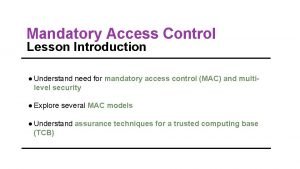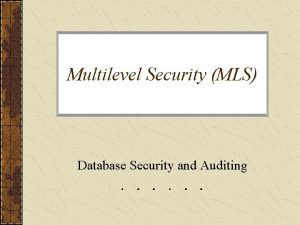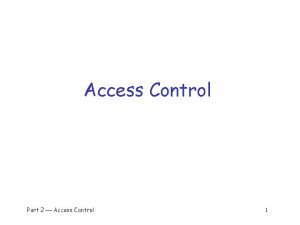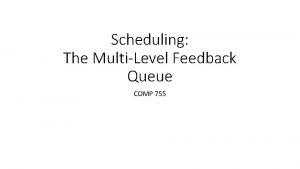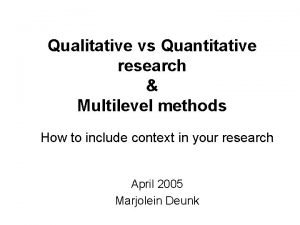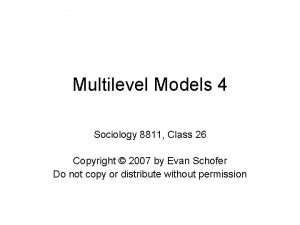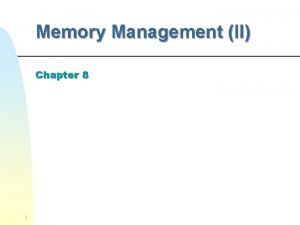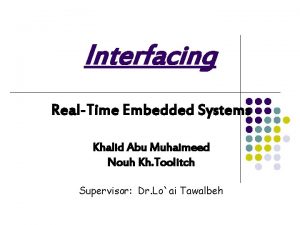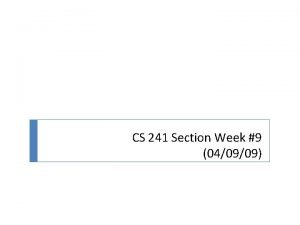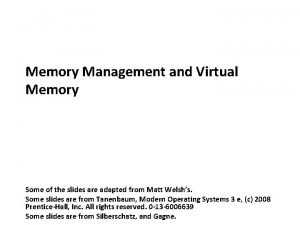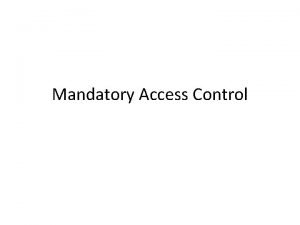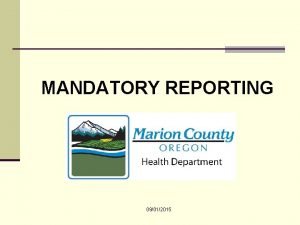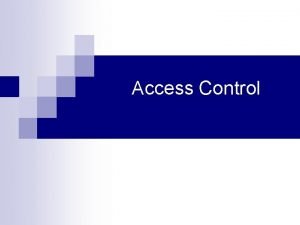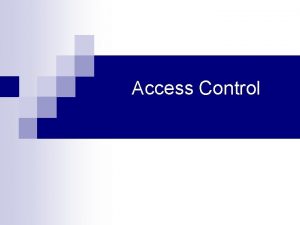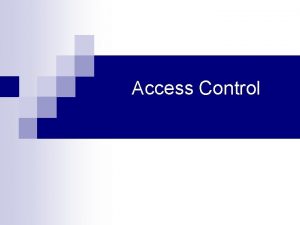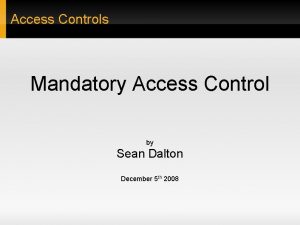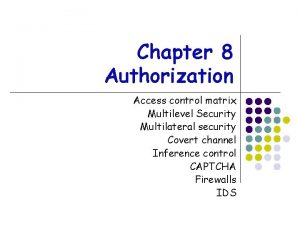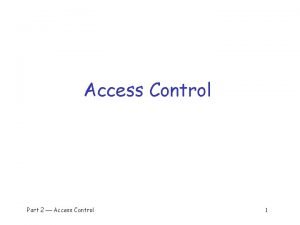Mandatory Access Control Multilevel Security MLS MLS needed
















- Slides: 16

Mandatory Access Control

Multilevel Security (MLS) • MLS needed when subjects/objects at different levels access the same system • MLS is a form of Access Control • Military and Government interest in MLS for many decades – Lots of research into MLS – Strengths and weaknesses of MLS well understood (almost entirely theoretical) – Many possible uses of MLS outside military

MLS Applications • Classified Government/Military systems • Business example: info restricted to – Senior Management only, – All Management, – Everyone in company, or – General public • Network firewall • Confidential medical info, databases, etc. • Usually, MLS are not really a technical system – More like part of a legal structure

MLS Security Models • MLS models explain what needs to be done • Models do not tell you how to implement • Models are descriptive, not prescriptive – That is, high-level description, not an algorithm • There are many MLS models • We’ll discuss simplest MLS model – Other models are more complex, more difficult to enforce, harder to verify, etc.

1. Bell-La. Padula (BLP) • BLP security model designed to express essential requirements for MLS – Captures the minimal requirements with respect to the Confidentiality. • BLP deals with Confidentiality – To prevent unauthorized reading • Let’s assume that O is an object, S is a subject – Object O has a Classification – Subject S has a Clearance – Security level denoted L(O) and L(S)

Bell-La. Padula • BLP consists of Simple Security Condition: S can read O if and only if (iff) L(O) L(S) *-Property (Star Property): S can write O if and only if (iff) L(S) L(O) • No read up, no write down

Bell-La. Padula: Basics • Mandatory access control – Entities are assigned security levels – Subject has security clearance L(S) = ls – Object has security classification L(O) = lo – Simplest case: Security levels are arranged in a linear order li < li+1 • Example Top Secret > Confidential >Unclassified

“No Read Up” • Information is allowed to flow up, not down • Simple security property: – S can read O if and only if • lo ≤ ls and • S has discretionary (available for use) read access to O - Combines mandatory (security levels) and discretionary (permission required) - Prevents subjects from reading objects at higher levels (No Read Up Rule)

“No Write Down” • Information is allowed to flow up, not down • *property – S can write O if and only if • ls ≤ lo and • S has write access to O - Combines mandatory (security levels) and discretionary (permission required) - Prevents subjects from writing to objects at lower levels (No Write Down Rule)

Example security level subject object Top Secret Tamara Personnel Files Secret Samuel E-Mail Files Confidential Claire Activity Logs Unclassified Ulaley Telephone Lists • Tamara can read which objects? And she can write? • Claire cannot read which objects? And she cannot write? • Ulaley can read which objects? And she can write? Remember: No read up, no write down

BLP: The Bottom Line • BLP is simple, probably too simple • BLP is one of the few security models that can be used to prove things about systems • BLP has inspired other security models – Most other models try to be more realistic – Other security models are more complex – Models difficult to analyze, apply in practice

Biba’s Model • BLP for confidentiality, Biba for integrity – Biba is to prevent unauthorized writing • Biba is (in a sense) the dual of BLP • Integrity model – Suppose you trust the integrity of O 1 but not O 2 – If object O includes O 1 and O 2 then you cannot trust the integrity of O • Integrity level of O is minimum of the integrity of any object in O • Low water mark principle for integrity • For confidentiality: we apply high water mark

Biba’s Integrity Policy Model • Based on Bell-La. Padula – Subject, Objects have • Integrity Levels with dominance relation – Higher levels • More reliable/trustworthy • More accurate

Biba • Let I(O) denote the integrity of object O and I(S) denote the integrity of subject S • Biba can be stated as Write Access Rule: S can write O if and only if I(O) I(S) (otherwise O will be contaminated with the untrusted S) Biba’s Model: S can read O if and only if I(S) I(O) (otherwise S will be contaminated with the untrusted O) • It is very restrictive, so it is often replaced with Low Water Mark Policy: If S reads O, then I(S) = Min( I(S) , I(O) )

Biba’s model • Strict Integrity Policy (dual of Bell-La. Padula) – Note: you may think of it as a military command – S can read O iff I(S) ≤ I(O) (No Read-Down) • Why? – S can write O iff I(O) ≤ I(S) (No Write-Up) • Why? 15

BLP vs. Biba high l e v e l low BLP L(O 1) Biba L(O) L(O 2) Confidentiality high l e v e l I(O 1) I(O 2) Integrity I(O) low
 Mandatory access control (mac)
Mandatory access control (mac) Multi level security example
Multi level security example Multilevel database security
Multilevel database security Terminal access controller access control system
Terminal access controller access control system Terminal access controller access-control system
Terminal access controller access-control system Privatesecurity
Privatesecurity The multilateral security enforces access control
The multilateral security enforces access control Access control matrix
Access control matrix Multi level page table
Multi level page table Teaching multilevel esl classes
Teaching multilevel esl classes Multilevel feedback queue scheduling
Multilevel feedback queue scheduling Multilevel model equation example
Multilevel model equation example Multilevel model equation example
Multilevel model equation example Multilevel paging in os
Multilevel paging in os Multilevel bus architecture
Multilevel bus architecture Multilevel page tables
Multilevel page tables Virtual memory linux
Virtual memory linux
